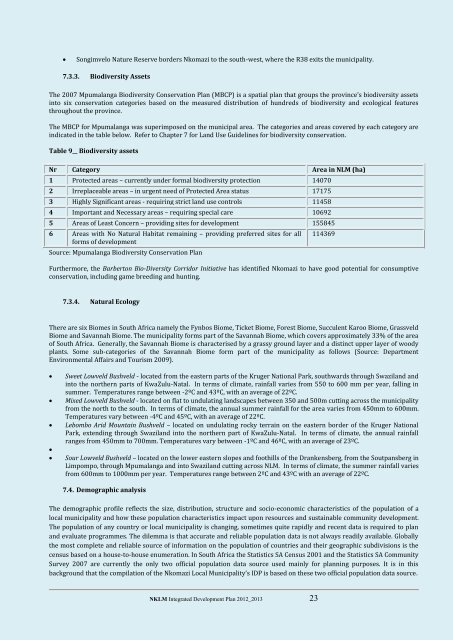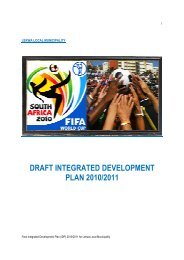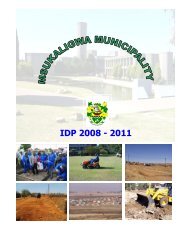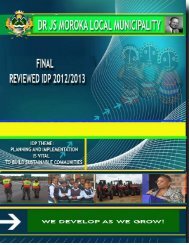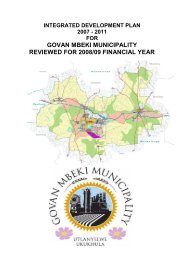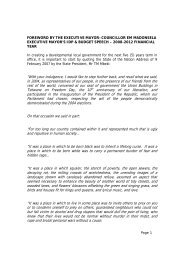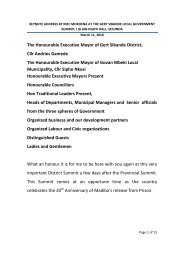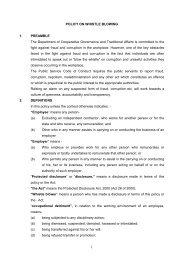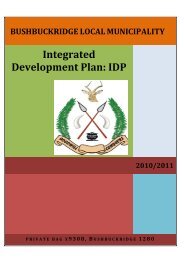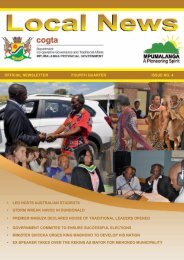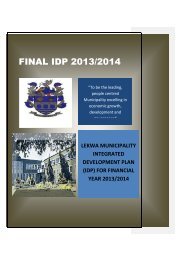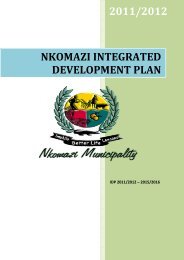Nkomazi Local Municipality 20 - Co-operative Governance and ...
Nkomazi Local Municipality 20 - Co-operative Governance and ...
Nkomazi Local Municipality 20 - Co-operative Governance and ...
- No tags were found...
Create successful ePaper yourself
Turn your PDF publications into a flip-book with our unique Google optimized e-Paper software.
Songimvelo Nature Reserve borders <strong>Nkomazi</strong> to the south-west, where the R38 exits the municipality.7.3.3. Biodiversity AssetsThe <strong>20</strong>07 Mpumalanga Biodiversity <strong>Co</strong>nservation Plan (MBCP) is a spatial plan that groups the province’s biodiversity assetsinto six conservation categories based on the measured distribution of hundreds of biodiversity <strong>and</strong> ecological featuresthroughout the province.The MBCP for Mpumalanga was superimposed on the municipal area. The categories <strong>and</strong> areas covered by each category areindicated in the table below. Refer to Chapter 7 for L<strong>and</strong> Use Guidelines for biodiversity conservation.Table 9__ Biodiversity assetsNr Category Area in NLM (ha)1 Protected areas – currently under formal biodiversity protection 140702 Irreplaceable areas – in urgent need of Protected Area status 171753 Highly Significant areas - requiring strict l<strong>and</strong> use controls 114584 Important <strong>and</strong> Necessary areas – requiring special care 106925 Areas of Least <strong>Co</strong>ncern – providing sites for development 1558456 Areas with No Natural Habitat remaining – providing preferred sites for allforms of developmentSource: Mpumalanga Biodiversity <strong>Co</strong>nservation Plan114369Furthermore, the Barberton Bio-Diversity <strong>Co</strong>rridor Initiative has identified <strong>Nkomazi</strong> to have good potential for consumptiveconservation, including game breeding <strong>and</strong> hunting.7.3.4. Natural EcologyThere are six Biomes in South Africa namely the Fynbos Biome, Ticket Biome, Forest Biome, Succulent Karoo Biome, GrassveldBiome <strong>and</strong> Savannah Biome. The municipality forms part of the Savannah Biome, which covers approximately 33% of the areaof South Africa. Generally, the Savannah Biome is characterised by a grassy ground layer <strong>and</strong> a distinct upper layer of woodyplants. Some sub-categories of the Savannah Biome form part of the municipality as follows (Source: DepartmentEnvironmental Affairs <strong>and</strong> Tourism <strong>20</strong>09).Sweet Lowveld Bushveld - located from the eastern parts of the Kruger National Park, southwards through Swazil<strong>and</strong> <strong>and</strong>into the northern parts of KwaZulu-Natal. In terms of climate, rainfall varies from 550 to 600 mm per year, falling insummer. Temperatures range between -2ºC <strong>and</strong> 43ºC, with an average of 22ºC.Mixed Lowveld Bushveld - located on flat to undulating l<strong>and</strong>scapes between 350 <strong>and</strong> 500m cutting across the municipalityfrom the north to the south. In terms of climate, the annual summer rainfall for the area varies from 450mm to 600mm.Temperatures vary between -4ºC <strong>and</strong> 45ºC, with an average of 22ºC.Lebombo Arid Mountain Bushveld – located on undulating rocky terrain on the eastern border of the Kruger NationalPark, extending through Swazil<strong>and</strong> into the northern part of KwaZulu-Natal. In terms of climate, the annual rainfallranges from 450mm to 700mm. Temperatures vary between -1ºC <strong>and</strong> 46ºC, with an average of 23ºC.Sour Lowveld Bushveld – located on the lower eastern slopes <strong>and</strong> foothills of the Drankensberg, from the Soutpansberg inLimpompo, through Mpumalanga <strong>and</strong> into Swazil<strong>and</strong> cutting across NLM. In terms of climate, the summer rainfall variesfrom 600mm to 1000mm per year. Temperatures range between 2ºC <strong>and</strong> 43ºC with an average of 22ºC.7.4. Demographic analysisThe demographic profile reflects the size, distribution, structure <strong>and</strong> socio-economic characteristics of the population of alocal municipality <strong>and</strong> how these population characteristics impact upon resources <strong>and</strong> sustainable community development.The population of any country or local municipality is changing, sometimes quite rapidly <strong>and</strong> recent data is required to plan<strong>and</strong> evaluate programmes. The dilemma is that accurate <strong>and</strong> reliable population data is not always readily available. Globallythe most complete <strong>and</strong> reliable source of information on the population of countries <strong>and</strong> their geographic subdivisions is thecensus based on a house-to-house enumeration. In South Africa the Statistics SA Census <strong>20</strong>01 <strong>and</strong> the Statistics SA <strong>Co</strong>mmunitySurvey <strong>20</strong>07 are currently the only two official population data source used mainly for planning purposes. It is in thisbackground that the compilation of the <strong>Nkomazi</strong> <strong>Local</strong> <strong>Municipality</strong>’s IDP is based on these two official population data source.NKLM Integrated Development Plan <strong>20</strong>12_<strong>20</strong>13 23


